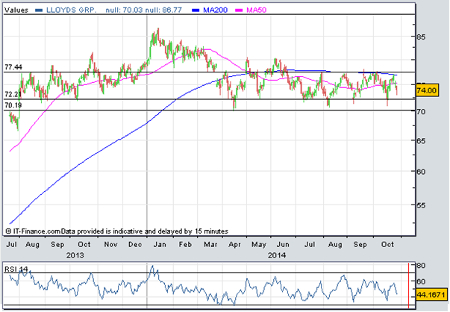"Magic" 100p in sight for Lloyds?
28th October 2014 15:05
by Harriet Mann from interactive investor
Share on
The recovery of seems to be on track with the release of better-than-expected third-quarter results. A further cut to its work force by 10% should slash costs, a move which some reckon could make it one of the most efficient banks in Europe.
Underlying profit rose by 41% to £2.2 billion in the third quarter, thanks to a boost to net interest income (up 10% to just over £3 billion), lower impairments and slight reduction to costs. Excluding the impact of its disposal of St. James's Place last year, profit rose by over a half in the first nine months of the year. Despite a larger-than-expected £900 million PPI hit in the third quarter, statutory pre-tax profit rose to £751 million from a £440 million loss last year. Net tangible asset value per share grew to 51.8p.
"No surprises the markets did not react well to the miss-selling front with PPI totalling another £900 million," said James Abbott, a trader at Accendo Market. "However, once these cobwebs are all out the cupboard what will hold this company back?"
In a strategic update, Lloyds announced plans to reduce its cost:income ratio to around 45% by the end of 2017, a reflection of improving efficiency within the group. With a ratio of 47% currently, Deutsche Bank analyst Jason Napier reckons this is a "credible" goal: "If achieved, Lloyds will be amongst the most efficient large banks in Europe," he said.

(click to enlarge)
Lloyds also laid out plans for annual savings of £1 billion within three years, improve its asset quality ratio and boost sustainable returns by up to 15%. Lloyds' return on risk-weighted assets increased to 3.4% in the quarter.
Prior to the results, Lloyds' shares slid after results from European Banking Authority's (EBA) eurozone stress tests. The EBA noted that the group's common equity ratio tier 1 (CET1) ratio (a measure of its financial strength) was lower than expected in the 2016 adverse circumstances guidance. A bank is known as "well capitalised" when its ratio is 6% or above. Its 2016 baseline figure sits at 13.6% - one of the highest versus its peers - but falls to just 6.2% - one of the lowest - in an adverse scenario.
Lloyds' fully-loaded CET-1 ratio reached 12% from 10% last December, showing greater capital adequacy. While talks are ongoing with the Prudential Regulation Authority (PRA) to reinstate dividends, Investec expects a "token" 1p dividend for the second half of 2014, predicting a rise to 4.5p by 2016, with earnings per share of 7.9p and prospective dividend yield of 6%. With a 'buy' recommendation and 86p target price, Lloyds is trading on 1.2 times 2016 tangible net asset value (TNAV).
With Lloyds shares the most-traded on Interactive Investor Tuesday, Abbott was optimistic after the release: "This company could be soon offering everything; growth and income which investors are waiting for. Could this be the catalyst to push the shares towards the magic 100p mark?"
Well, Lloyds shares have been largely range-bound since March (see chart above) and they're unlikely to hit 100p any time soon. That said, a current-year price/TNAV ratio of 1.4 is still well below pre-credit crunch levels and Lloyds will likely return to the dividend list soon. Any pick-up in market sentiment should rub off on the shares.
This article is for information and discussion purposes only and does not form a recommendation to invest or otherwise. The value of an investment may fall. The investments referred to in this article may not be suitable for all investors, and if in doubt, an investor should seek advice from a qualified investment adviser.